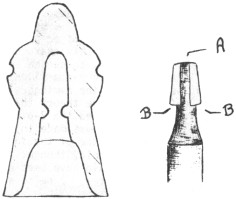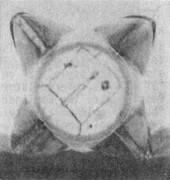Patent Pages
by Ray Klingensmith
Reprinted from "INSULATORS - Crown Jewels of the Wire", April 1978, page 14
This month the featured patent is the "elusive Emminger". And
elusive this insulator certainly is. It was patented by David R. P. Emminger on
February 20th, 1872, being issued patent number 123,878. The patent reads "
The nature of my invention consists in so constructing my improved 'insulator'
that dust and dirt are prevented from accumulating upon its outer surface. Also
in reducing the points of contact of the conducting wire with the insulator, in
a great degree, by a peculiar method of construction of said insulator."
"Upon its outer surface, a proper distance from the upper rounded end, four
rhombus or lozenge-shaped projections aaaa, are formed. These projections have
circular or rounded notches formed in their outer edges a proper distance from
their terminations. They are intended to receive and retain in place the
binding wire that secures the conducting wire to the insulator."
And a "peculiar" design Emminger did in fact produce. This must
have been a very good design, as all Emmingers known to me were in fact free of
any dust and dirt deposits. All were very clean.
And how many Emmingers are
there in collections? There are a definite seven, and possibly two others which
have not definitely been confirmed. Of the seven positively existing, only one
is "mint", the rest having varying degrees of damage. Although these
are now widely scattered across the country, it seems the original location for
their appearance is Pennsylvania. The one mint one that turned up several years
ago in Ohio, was purchased from an individual from an unknown location. (ref.
Great Lakes Show, 1975. The person who brought this mint Emminger was from Ohio. But the person he acquired it from
could have been from elsewhere.)
Another interesting feature of this patent,
other than the four projections, is the type of pin to be used. Although this
insulator has been found with only a standard threaded pinhole, it has an unusual "special threadless" pinhole in the patent drawings. (See my
drawings below for this unusual feature.) The insulator was to have a smooth
threadless pinhole. At the lower portion of the pinhole or recess, two knobs
were formed opposite each other. A special pin was made with two parallel
grooves positioned in a manner to receive the knobs within the insulator. The
pin was formed so that the insulator could be aligned on the pin (knobs on
insulator with grooves on pin), then pressed downward and turned so as to lock
it in position. The insulator could not rise, as the knobs were under the
shoulder. (See drawing below.) Although no one has found an Emminger with this
special feature, to my knowledge, it certainly is interesting and gives us
something to look for. Imagine a threadless Emminger!

Drawings showing interior "knobs" and unusual grooved pin. The
knobs fit into the grooves (A) and were turned under the shoulder (B). |

Top view photo showing "creases" design in top of pinhole very similar to
those found in Paisleys. |
As with many other "patents", the main feature on the insulator is
the same, and another aspect of the insulator is different than that of the
patent drawings. In this case it is the type of pin to be used. There are
several explanations as to why all Emmingers found so far are all threaded.
First: A small amount of the "special threadless" were possibly
manufactured, used, and found unsatisfactory. Second: This early patent date was
just after the use of the threaded pin was becoming popular, and Emminger,
between the time he applied for the patent (most likely mid 1871), and the time
of manufacturing, realized the advantage of using a threaded pin, and had it
manufactured that way. Third: The knobs in the pinhole would require special
manufacturing moulds and skills, and was therefore abandoned. Fourth: When
Emminger contracted with a manufacturer to make them, the manufacturer suggested
the advantages of a threaded interior, and they were made that way.
Who made the
Emminger? We really have very little to go on when it comes to the manufacturer.
Let's examine a few possibilities. Some may feel the base embossing suggests a
Boston, Massachusetts, area manufacturer. My opinion on this, is that it wasn't. First, because of
the early Emminger date (1872). Boston Bottle Works was in business from
1872-1877. American Ins. Co., National, Standard and others were much later. So
the only likely possibility would be Boston Bottle Works. Oakman was more than
likely using his own slotted threadless pinhole in early 1872, and his
segmented-threads in late 1872 and the years to follow. Only one style of a
"Boston" has been found with full threading. For those reasons the
Boston area is unlikely in my opinion, but it still is a possibility.
Another
possibility is S.T. Paisley. And this possibility I seem to favor for some
"instinctive feeling". Paisley was listed as a mould maker in Beaver
Falls, Pennsylvania. There once was a Beaver Glass Co., and a Valley Glass Co.
in Beaver Falls, Pennsylvania. I'm not sure of the exact manufacturing dates. We
know Paisley was making early (Appearance of glass and styles made seem to be ca. 1870's.) threaded insulators for someone. (Paisley
could also have made the CD 733.2 with M on the
dome.) Every embossed Paisley, unembossed 132.2, and other "Paisley styles"
that I've ever seen had one thing in common: a "crease" in the top of
the pinhole in various shapes--

These must have been caused by a unique
characteristic in the mandrels or plungers Paisley used. (EC&M's are the
only other items with this characteristic.) The Emminger also has this unusual
"crease", as can be seen in the top view photo. The CD 132.2 in my
collection has a slightly similar (in style) "2" on the dome. (The
oddity of the Emmingers' "2" will be covered later.) The only soft
spot in the theory that Paisley made the Emminger is the fact that Paisley used
the 3-piece "button" mold on all styles I know of. The Emminger was
made in a 2-piece mold (mold line over dome). The peculiar shape of the
insulator could explain the reason for using a 2-piece mold, though.
The third,
and another likely manufacturer, could have been one of several glass works of
the time in the general area. I believe Lancaster Glass Wks. was still in
business at that time. This is a likely candidate, as Emminger didn't live too
far from Lancaster. There were several glass houses in Philadelphia and
Pittsburgh, Pennsylvania, and New Jersey that could also have made them. I feel
it wasn't an item made by either Hemingray or Brookfield.
As mentioned above,
there is a special characteristic in the "2" embossed on the Emminger.
It has a long curved tail (See base photo and rubbing of embossing.). This is
another feature which adds to the "class" of this Insulator. If anyone
has a CD 132.2 or any other insulator with the fancy "tailed 2",
please send a rubbing of it, as it would help confirm the manufacturer.
In this
day and age of space travel, supersonic speed, pyramid power, "Close
Encounters", UFO's and the unknown, David Emminger may have had a design
with much more meaning than just a technical Improvement. It does have a
peculiar pyramid shape. It's an item I've been chasing for a long time. It just
has something about it. Many collectors and non-collectors alike say one thing
in common: "It looks like it's ready to take off." I guarantee you one
thing, If I'm ever fortunate enough to own one of these jewels, I probably won't
hit the ground for a week! And to all the people who are fortunate enough to own
an Emminger -- We all envy you.
Anyone have anything to add? If so, contact me at
709 Rt. 322, East Orwell, Ohio 44034. Next month: the 1874 Brooke's Patent.
Special Note: A real big thanks to Mike Johnson for his trouble and time
involved in bringing this jewel to a "photo session".
|
